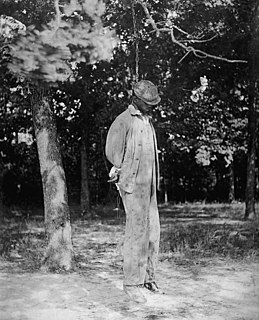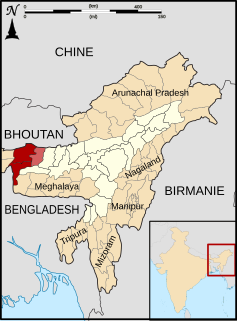Related Research Articles

Lynching is an extrajudicial killing by a group. It is most often used to characterize informal public executions by a mob in order to punish an alleged transgressor, punish a convicted transgressor, or intimidate people. It can also be an extreme form of informal group social control, and it is often conducted with the display of a public spectacle for maximum intimidation. Instances of lynchings and similar mob violence can be found in every society.

The 2000 Ramallah lynching was a violent incident that took place on October 12, 2000 – early in the Al-Aqsa Intifada – at the el-Bireh police station, where a Palestinian crowd of passing funeral marchers broke in and killed and mutilated the bodies of two Israel Defense Forces reservists.

The 1977 anti-Tamil pogrom in Sri Lanka followed the 1977 general elections in Sri Lanka where the Sri Lankan Tamil nationalistic Tamil United Liberation Front won a plurality of minority Sri Lankan Tamil votes in which it stood for secession. An official estimate put the death toll at 125. The Tamil Refugees Rehabilitation Organization estimated that around 300 Tamils were killed by Sinhalese mobs. Human rights groups, such as the UTHR-J, accused the newly elected UNP run Sri Lankan government of orchestrating the violence. Though the majority of victims were Tamils, Sinhalese in Tamil majority areas were also affected by violence committed by Tamil mobs.
In November and December 2006, the desecration of an Ambedkar statue in Kanpur triggered off violent protests by Dalits in Maharashtra, India.
The Arnon Street killings, also referred to as the Arnon Street murders or the Arnon Street massacre, took place on 1 April 1922 in Belfast, Northern Ireland. Six Catholic civilians, three in Arnon Street, were shot dead. It is believed that members of either the Ulster Special Constabulary (USC) or of the Royal Irish Constabulary (RIC) were responsible, acting in retaliation for the killing of an RIC officer by the Irish Republican Army (IRA).
From 1967 to 1973, an extended period of racial unrest occurred in the town of Cairo, Illinois. The city had long had racial tensions which boiled over after a black soldier was found hanged in his jail cell. Over the next several years, fire bombings, racially charged boycotts and shootouts were common place in Cairo, with 170 nights of gunfire reported in 1969 alone.

The 2010 Kashmir unrest was a series of violent protests and riots in the Kashmir Division and Northern Jammu Division of Jammu and Kashmir, India which started in June 2010 after the Indian Army claimed to have killed three Pakistani infiltrators in which a soldier of the Territorial Army, a counter-insurgent and a former special police officer had found three young men from their Nadihal village in Baramulla district and killed them in a "staged" encounter at Sona Pindi. The protests occurred in a movement launched by Hurriyat Conference led by Syed Ali Shah Geelani and Mirwaiz Umar Farooq in the Indian state of Jammu and Kashmir in June 2010, who called for the complete demilitarisation of Jammu and Kashmir. The All Parties Hurriyat Conference made this call to a strike, citing human rights abuses by security forces. Rioters shouting pro-independence slogans, defied curfew, attacked riot police with stones and burnt vehicles and buildings. The protests started out as anti India protests but later were also targeted against the United States following the 2010 Qur'an-burning controversy. The riot police consisting of Jammu and Kashmir Police and Indian Para-military forces fired teargas shells rubber bullets and also live ammunition on the protesters, resulting in 112 deaths, including many teenagers and an 11-year-old boy. The protests subsided after the Indian government announced a package of measures aimed at defusing the tensions in September 2010.
The Paramakudi riots were a series of riots that happened from 10 to 13 September 2011 in Paramakudi, in the Ramanathapuram district. The riots were held in response to the detention of Tamizhaga Makkal Munnetra Kazhagam (TMMK) leader John Pandian who was detained while heading to Paramakudi to commemorate the 54th death anniversary of Immanuvel Devendrar, a revolutionary leader from the Pallar caste.

In July 2012, violence in the Indian state of Assam broke out with riots between indigenous Bodos and Bengali speaking Muslims. The first incident was reported to have taken place on 20 July 2012. As of 8 August 2012, 77 people had died and over 400,000 people were taking shelter in 270 relief camps, after being displaced from almost 400 villages. Eleven people have been reported missing.
Azad Maidan Riot refers to a riot by Indian muslims, organised in Azad Maidan on 11 August 2012 to condemn the Rakhine riots and which started as a protest and later turned into a riot. The riot reportedly began as the crowd got angry either after hearing an inflammatory speech or after seeing photographs of Rakhine state riots. The riot resulted in two deaths and injuries to 63 people including 58 police officers. Mumbai Police estimated that the riots caused a loss of ₹2.74 crore in damages to public and private property.
The 2015 Dimapur mob lynching was a case of mob lynching that took place in Dimapur, Nagaland, India, on 5 March 2015. A mob of about 7000–8000 people broke into a prison, dragged a man detained under suspicion of rape out of the Dimapur Central Jail, paraded him naked and beat him to death in a case of vigilante justice.
The 1966 Chicago West Side riots was a public disorder that occurred between July 12 and 15 in Chicago, Illinois. After police arrested a man that was wanted for armed robbery, black residents took to the streets in anger and looted and burned various stores throughout the West Side until the arrival of 1,200 National Guardsmen on July 15. Violence quickly subsided and most of the troops were sent home on July 20.

Stone pelting in Kashmir refers to stone throwing by Kashmiris on the Indian forces and Jammu and Kashmir Police deployed for crowd control in Jammu and Kashmir to support the extremists group or terrorist. In the local language, it is termed as "Kanni Jung", which means fighting with stones and the stone pelters are called as Sangbaaz or Pathraw Player. However, in the recent past the number of stone pelting has dropped significantly.

The 2017 Nowhatta mob lynching, was the lynch mob murder and mutilation of an on-duty undercover Indian Police officer in J&K Muhammad Ayub Pandith, on the Muslim holy night of Laylat al-Qadr on Thursday 22 June 2017 by a mob in Nowhatta after a crowd shouted slogans in favor of Pakistan as well as al-Qaida jihadist Zakir Musa. Sajjad Ahmad Gilkar, a Hizbul Mujahideen militant, had played a key role in the lynching according to the state police.

Crowd control in Jammu and Kashmir is a public security practice to prevent and manage violent riots. It is enforced by police forces through laws preventing unlawful assembly, as well as using riot control agents such as tear gas, chili grenades, and pellet guns.

The 2020 Delhi riots, or North East Delhi riots, were multiple waves of bloodshed, property destruction, and rioting in North East Delhi, beginning on 23 February 2020 and caused chiefly by Hindu mobs attacking Muslims. Of the 53 people killed, two-thirds were Muslims who were shot, slashed with repeated blows, or set on fire. The dead also included a policeman, an intelligence officer and over a dozen Hindus, who were shot or assaulted. More than a week after the violence had ended, hundreds of wounded were languishing in inadequately staffed medical facilities and corpses were being found in open drains. By mid-March many Muslims had remained missing.
Stone pelting in India refers to criminal assault in the form of stone throwing by individuals or mob who pelt, bombard or throw stones at security personnel, police forces and healthcare workers. Stone pelting began with incidents of stone pelting in Kashmir, but became less frequent after the revocation of article 370 of the Constitution of India and the conversion of the state into union territories. These incidents were later reported in Delhi and Uttar Pradesh in 2019 in protest of the citizenship amendment act. In 2020, such incidents started occurring in various parts of India on doctors and policemen after the coronavirus lockdown.

On the night of 11 August and the early hours of 12 August 2020, violent clashes took place around the residence of a legislator and the police stations of KG Halli and DJ Halli of the Indian city of Bangalore, Karnataka. Provoked by a Facebook post on Muhammad that was allegedly shared by the nephew of Akhanda Srinivas Murthy, a state legislator of the Indian National Congress, a group of Muslims arrived at his house in protest with petrol bombs, clubs which later turned violent.
The 1997 Coimbatore riots occurred between 29 November 1997 and 1 December 1997 in Coimbatore triggered by a murder of a police constable allegedly by some Muslim youth over a dispute of detention of Al-Ummah functionaries by the police. The policemen revolted in response to the murder of the constable and in concert with the members of the Hindu Munnani and the Hindu Makkal Katchi, attacked Muslims and Muslim-owned properties. Clashes erupted between both the communities and the police reportedly opened fire targeting the Muslims killing ten. Many Muslim youth were beaten to death or burnt alive. Muslim-owned businesses in different parts of the city were looted and burnt down. At the end of the riots, 18 Muslims and 2 Hindus lost their lives.
References
- ↑ "International Religious Freedom Report 2008". US Department of State . Retrieved 19 January 2018.
- ↑ Annual Report on International Religious Freedom 2007, February 2008, 110-2 Report, *. 2008. p. 641.
- ↑ "Bhiwandi backlash: Two cops set on fire, curfew on | Jul 06,2006". Outlookindia.com. Retrieved 17 January 2016., Quote: "Two policemen were murdered and set on fire in a backlash by a mob after two persons were killed in police firing (...) Two persons were killed in police firing and at least 34 persons, mostly policemen, were injured in stone pelting by the mob yesterday. The deceased were identified as Ramjan Khan and Abdul Malik, both residents of the town."
- ↑ "Bhiwandi backlash: Two cops set on fire, curfew on | Jul 06,2006". Outlookindia.com. Retrieved 17 January 2016.
- ↑ "Charred bodies of two cops found in Bhiwandi after riot - Indian Express". Archive.indianexpress.com. 6 July 2006. Retrieved 17 January 2016.
- ↑ "Two policemen lynched; curfew in Bhiwandi". Timesofindia.indiatimes.com. 6 July 2006. Retrieved 17 January 2016.
- ↑ "2 policemen stabbed to death in Bhiwandi - Today's Paper". The Hindu. 7 July 2006. Retrieved 17 January 2016.
- ↑ "Mob, cops clash; 4 killed near Mumbai". Rediff.com. Retrieved 17 January 2016.
- ↑ Ashwin Aghor; Prashant Hamine (7 July 2006). "'Cops were stabbed and set on fire' | Latest News & Updates at Daily News & Analysis". Dnaindia.com. Retrieved 17 January 2016.